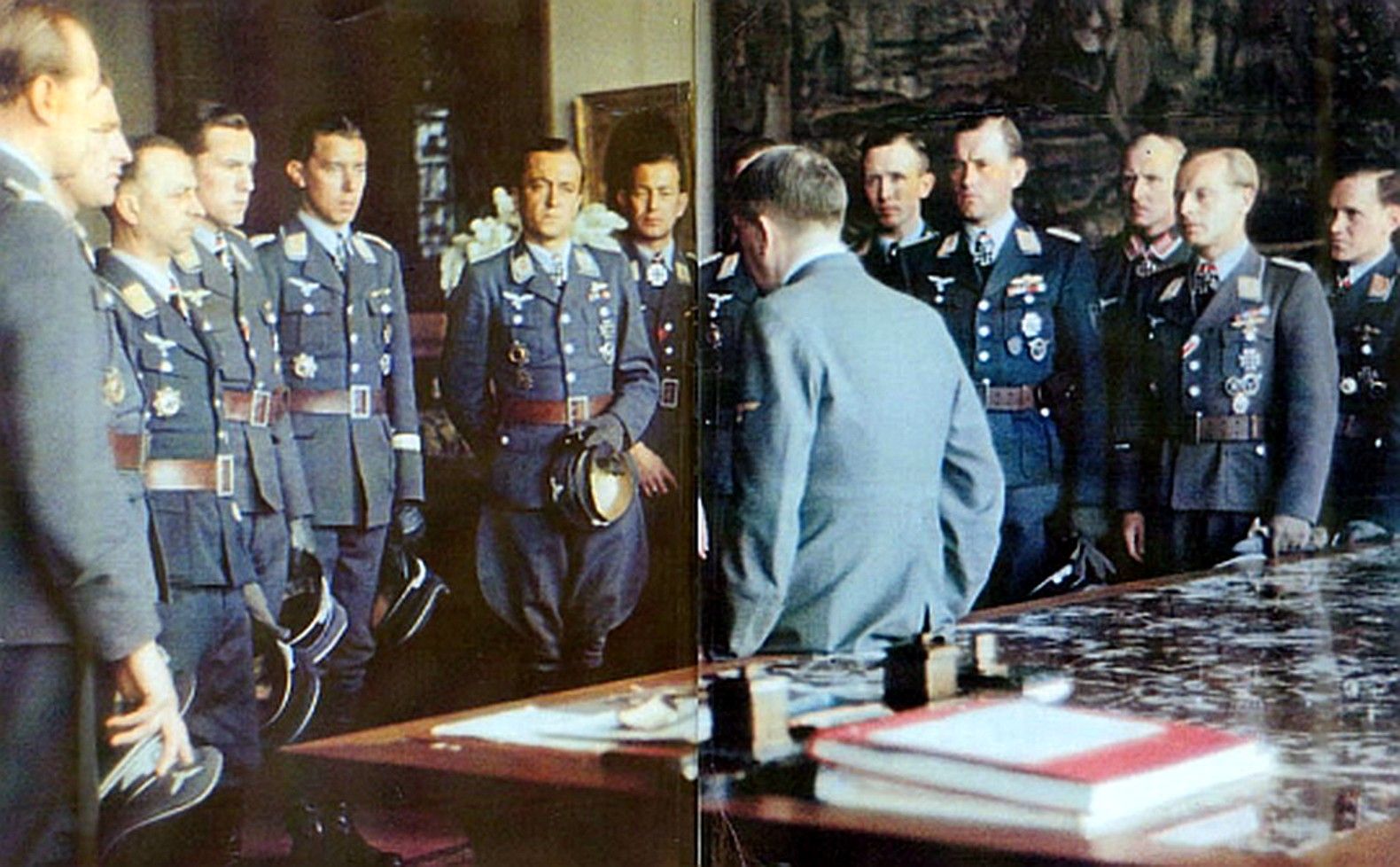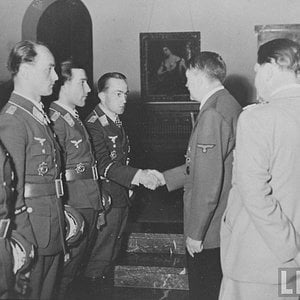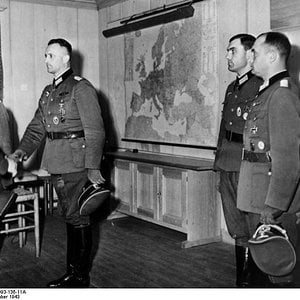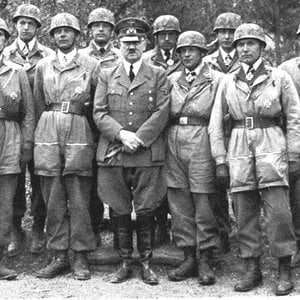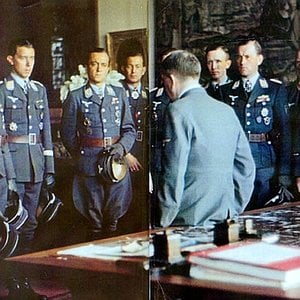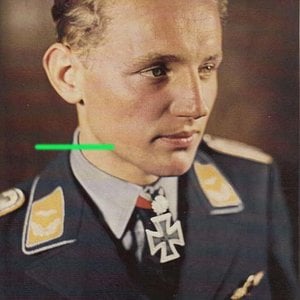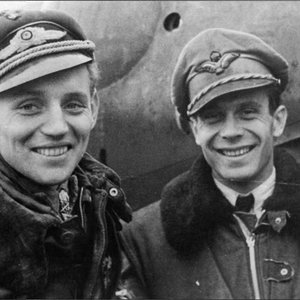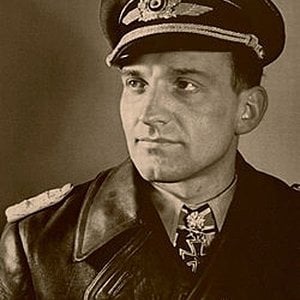Navigation
Install the app
How to install the app on iOS
Follow along with the video below to see how to install our site as a web app on your home screen.
Note: This feature may not be available in some browsers.
More options
You are using an out of date browser. It may not display this or other websites correctly.
You should upgrade or use an alternative browser.
You should upgrade or use an alternative browser.
Adolf Hitler after award ceremony for Luftwaffe officers at Berghof. From left to right :
1. Oberst Werner Streib : Luftwaffe night fighter
2. Major Gerhard Barkhorn : Luftwaffe day fighter
3. Generalmajor Erich Walther : Commander of a Fallschirmjäger regiment
4. Oberstleutnant Kurt Bühligen : Luftwaffe day fighter
5. Oberstleutnant Hans-Joachim Jabs : Luftwaffe night fighter
6. Oberstleutnant Bernhard Jope : Luftwaffe bomber Kommodore
7. Major Reinhard Seiler : Luftwaffe day fighter
8. Major Erich Hartmann ( hidden by Hitler) : Luftwaffe day fighter
9. Major Horst Ademeit : Luftwaffe day fighter
10. Major Johannes Wiese - Luftwaffe day fighter
11. Wachtmeister Fritz Petersen : Wehrmacht Artillery
12. Major Dr. Maximilian Otte : Luftwaffe Stuka pilot
13. Hauptmann Walter Krupinski : Luftwaffe day fighter
Fighting technique
Hartmann flew a Messerschmitt Bf 109 fighter.
Unlike Hans-Joachim Marseille, who was a marksman and expert in the art of deflection shooting, Hartmann was a master of stalk-and-ambush tactics. By his own account, he was convinced that 80% of the pilots he downed did not even realize what hit them. He relied on the powerful engine of his Bf-109 for high-power sweeps and quick approaches, occasionally diving through entire enemy formations to take advantage of the confusion that followed in order to disengage.
When the decorated British test pilot Captain Eric Brown asked Hartmann how he had amassed 352 air victories, he revealed:
Well you can't believe it, but the Sturmovik, which was their main ground-attack aircraft, flew like B-17s in formation and didn't attempt to make any evasive manoeuvres. And all they had was one peashooter in the back of each plane. Also, some of the pilots were women. Their peashooter was no threat unless they had a very lucky hit on you. I didn't open fire til the aircraft filled my whole windscreen. If I did this, I would get one every time.[34]
His favourite method of attack was to hold fire until extremely close (20 m (66 ft) or less), then unleash a short burst at point-blank range—a technique he learned while flying as wingman of his former commander, Walter Krupinski, who favoured this approach. This technique, as opposed to long-range shooting, allowed him to:[9][35]
reveal his position only at the last possible moment
compensate for the low muzzle velocity of the slower firing 30 mm MK 108 equipping some of the later Bf 109 models (though most of his victories were claimed with Messerschmitts equipped with the high-velocity MG 151 cannon)
place his shots accurately with minimum waste of ammunition
prevent the adversary from taking evasive actions
However, firing at close range ran the risk of having to fly through the debris of a damaged or exploding aircraft, thereby damaging his own fighter in the process (much of the damage Hartmann sustained in combat was caused by collision with flying debris). If it was dangerous to dog-fight further he would break off and content himself with one victory. His careful approach was described by himself by the line "See – Decide – Attack – Break": observe the enemy, decide how to proceed with the attack, make the attack, and then disengage to re-evaluate the situation.[9]
1. Oberst Werner Streib : Luftwaffe night fighter
2. Major Gerhard Barkhorn : Luftwaffe day fighter
3. Generalmajor Erich Walther : Commander of a Fallschirmjäger regiment
4. Oberstleutnant Kurt Bühligen : Luftwaffe day fighter
5. Oberstleutnant Hans-Joachim Jabs : Luftwaffe night fighter
6. Oberstleutnant Bernhard Jope : Luftwaffe bomber Kommodore
7. Major Reinhard Seiler : Luftwaffe day fighter
8. Major Erich Hartmann ( hidden by Hitler) : Luftwaffe day fighter
9. Major Horst Ademeit : Luftwaffe day fighter
10. Major Johannes Wiese - Luftwaffe day fighter
11. Wachtmeister Fritz Petersen : Wehrmacht Artillery
12. Major Dr. Maximilian Otte : Luftwaffe Stuka pilot
13. Hauptmann Walter Krupinski : Luftwaffe day fighter
Fighting technique
Hartmann flew a Messerschmitt Bf 109 fighter.
Unlike Hans-Joachim Marseille, who was a marksman and expert in the art of deflection shooting, Hartmann was a master of stalk-and-ambush tactics. By his own account, he was convinced that 80% of the pilots he downed did not even realize what hit them. He relied on the powerful engine of his Bf-109 for high-power sweeps and quick approaches, occasionally diving through entire enemy formations to take advantage of the confusion that followed in order to disengage.
When the decorated British test pilot Captain Eric Brown asked Hartmann how he had amassed 352 air victories, he revealed:
Well you can't believe it, but the Sturmovik, which was their main ground-attack aircraft, flew like B-17s in formation and didn't attempt to make any evasive manoeuvres. And all they had was one peashooter in the back of each plane. Also, some of the pilots were women. Their peashooter was no threat unless they had a very lucky hit on you. I didn't open fire til the aircraft filled my whole windscreen. If I did this, I would get one every time.[34]
His favourite method of attack was to hold fire until extremely close (20 m (66 ft) or less), then unleash a short burst at point-blank range—a technique he learned while flying as wingman of his former commander, Walter Krupinski, who favoured this approach. This technique, as opposed to long-range shooting, allowed him to:[9][35]
reveal his position only at the last possible moment
compensate for the low muzzle velocity of the slower firing 30 mm MK 108 equipping some of the later Bf 109 models (though most of his victories were claimed with Messerschmitts equipped with the high-velocity MG 151 cannon)
place his shots accurately with minimum waste of ammunition
prevent the adversary from taking evasive actions
However, firing at close range ran the risk of having to fly through the debris of a damaged or exploding aircraft, thereby damaging his own fighter in the process (much of the damage Hartmann sustained in combat was caused by collision with flying debris). If it was dangerous to dog-fight further he would break off and content himself with one victory. His careful approach was described by himself by the line "See – Decide – Attack – Break": observe the enemy, decide how to proceed with the attack, make the attack, and then disengage to re-evaluate the situation.[9]

